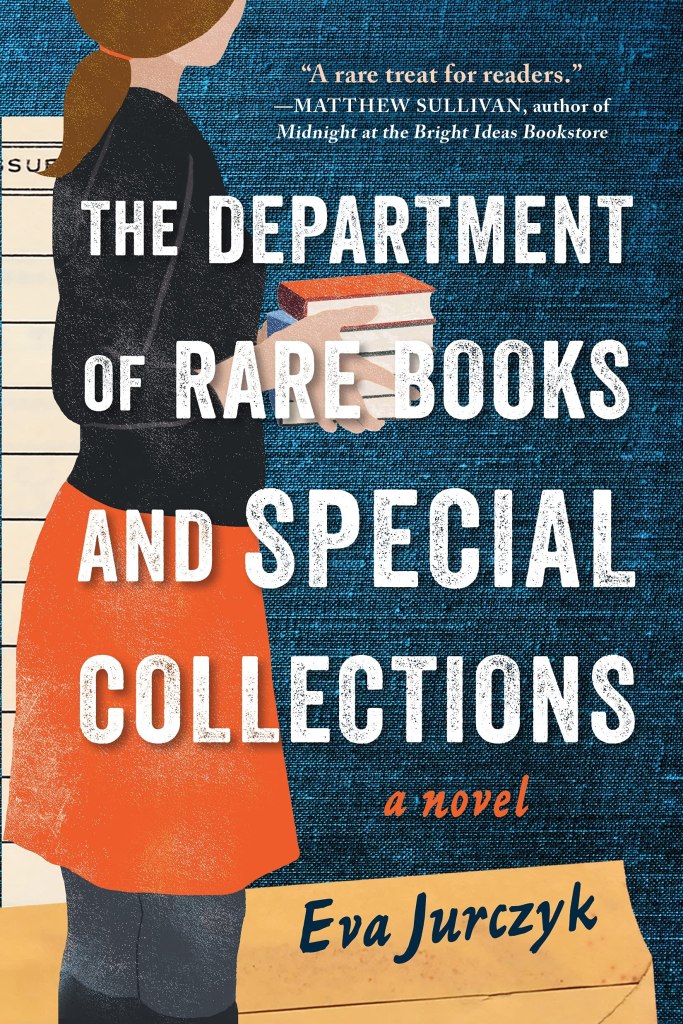
Liesl Weiss long ago learned to be content working behind the scenes in the distinguished rare books department of a large university, managing details and working behind the scenes to make the head of the department look good. But when her boss has a stroke and she’s left to run things, she discovers that the library’s most prized manuscript is missing.
Liesl tries to sound the alarm and inform the police about the missing priceless book, but is told repeatedly to keep quiet, to keep the doors open and the donors happy. But then a librarian unexpectedly stops showing up to work.
Many thanks to NetGalley, to Jurczyk and to Poisoned Pen Press for allowing me to read this ARC.
Books about books and libraries are always a draw for me as a book lover; crime and thrillers are usually, for me, a reliable go-to genre. A thriller set in a library in which precious books – and co-workers – disappear? I so wanted to love this one!
Alas, reader, I did not.
The premise is spot on – Christopher Wolfe, the Director of a University Library has a stroke and is rushed to hospital; the Assistant Director, Liesel Weiss, is recalled from a sabbatical to manage the library and to open the safe in which the recently purchased copy of the Plantin Polyglot Bible had been secured. Once the safe is opened, it is discovered to be empty and the Plantin Bible is missing. Is it misplaced, lost or stolen? Should Liesel involve the police? The stakes seem to rise as a colleague, Miriam Vivek, unexpectedly fails to arrive at work a few days later, and is eventually declared missing.
The books cited in the novel – the Plantin Polyglot Bible, the Peshawar manuscript, the Vesalius – are all real historically important texts. The Peshawar or Bakhshali contains the first historically recorded use of the zero. The bible was printed by Plantin as a way to prove his loyalty after being accused of being Calvinist, and the novels focus on and quest to recover this text may be ironic: the novel does explore and test the characters’ loyalty to each other, to the library, to the texts they house and to their families and spouses.
Jurczyk tries to balance a number of plots and subplots in the novel: Liesel has a complex relationship with her depressive husband, John, and a romantic history with a co-worker, Frances, that re-emerges; the disappearance of the Plantin bible leads to suspicions that any of the library staff – Frances, Max, Miriam, Dan – could have been a thief; there is Miriam’s disappearance, which leads to police involvement; a request from Rhonda, a mathematics professor, to carbon date the Peshawar; there are book fairs and presentations and receptions to be held and attended; and alongside that, the day-to-day work of the library.
The problem for me is the distance that Jurcyzk creates between her characters and the reader. There was so much exposition about the characters that I rarely felt that I was allowed to see them or to hear them. Conversation was often summarised in a sentence of reported speech where what I was craving after a few pages was just to hear their voices!
And it is such a shame because Jurcyzk can obviously write when she allows herself to. There was some lovely humour in there, particularly in the depiction of the University President Lawrence Garber who was – I hope intentionally – a comedic character, clad in cycling gear and cycling helmet and velcro strips around his ankles who
would occasionally drop to a crouch and yank at the handle of the safe as though he could force it open with 150-pound frame and sheer will.
Similarly, when she wants to, Jurcyzk can write with passion and enthusiam about the power of the physical book – which makes my reading of hers in an electronic form feel a little ironic! She describes the “sumptuous” beauty of the Plantin bible and “the flirty serifs”, or the annotations in the Vesalius which allowed the reader and the author to “know each other intimately. Had Christopher been working from facsimiles or from digital images, such a level of fraternity between the two men would have been impossible.”
Unfortunately, the majority of the novel neither manages to become the love letter to books that it had the potential to be, nor the tense thriller that it tried to be, nor the character-driven study that it might have been.
What I Liked
- Library-setting and plot revolving around books.
- The beautiful section describing the book that had been the subject of the novel.
- Older, near retirement age, female protagonist.
- Representation of mental health in both Miriam and John’s stories.
What Could Have Been Different
- The author could have sited us, the reader, much closer to the characters – the heavy use of reported speech rather than dialect, the heavy use of exposition created a lot of distance.
- For me, the novel lacked tension in either the threats or the tension between the library workers as they, generally, continued to operate as normal.
- Jurczyk did prove herself to be a wonderfully lyrical writer in some sections of the novel, but they were brief and sparse and the writing for the main felt rather… pedestrian and a little repetitive.
- The cover image – for a book featuring a near-retirement protagonist, the image on the cover suggests a much younger character…







[…] The Department of Rare Books and Special Collections, Eva Jurczyk […]
LikeLiked by 1 person
[…] Weiss in Department of Rare Books and Special Collections, […]
LikeLiked by 1 person